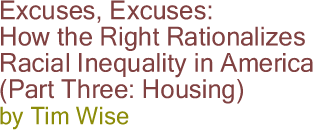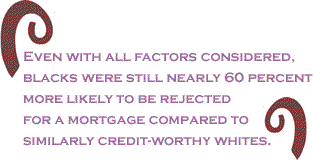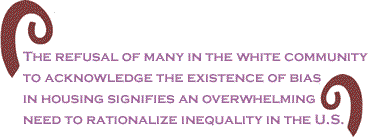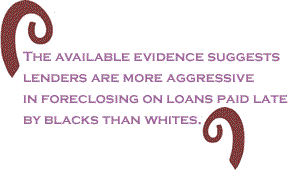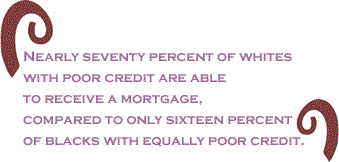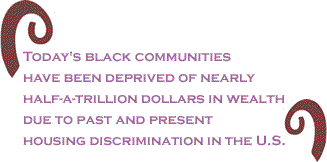
|
|||||||||||||||||||||
|
According to government estimates, between two and three million cases of housing discrimination take place each year, victimizing persons of color who seek to either purchase or rent a place to live. This discrimination takes several different forms, some of which are rather blatant, and others of which appear more subtle: claiming that the last apartment was just rented, when it fact it wasn't; charging higher interest rates for the same mortgage loan offered to a white person on better terms, or flatly rejecting persons of color for a loan at all, even while offering the same loans to whites with similar credit. Yet, despite decades of studies confirming the existence of housing bias, conservatives regularly devise and offer excuses for disparate housing outcomes, all of which presume that there are logical reasons why folks of color get loans less often, or on less favorable terms, and none of which reasons have the least bit to do with racism. As with white denial of racism in labor markets, the refusal of many in the white community to acknowledge the existence of bias in housing signifies an overwhelming need to rationalize inequality in the U.S. Although skeptics downplay discrimination against persons seeking to buy a home, by saying that higher mortgage rejection rates for blacks are merely the result of having worse credit histories, the facts say otherwise.
The most comprehensive study of mortgage bias was conducted by the Boston Federal Reserve Bank and considered 38 different factors that could result in disparate lending. Among the factors examined were several measures of income, credit history, loan type and collateral. Even with all factors considered, blacks were still nearly 60 percent more likely to be rejected for a mortgage compared to similarly credit-worthy whites. Despite criticisms of the Boston Fed study, the research has held up to extensive scrutiny. Indeed, the methodology of the study was considered sound enough by Boston banks so as to gain their participation to begin with, no doubt because they expected (incorrectly as it turned out) that the research would exonerate them from claims of bias. Furthermore, two follow-up studies, both of which added control variables, found equal or higher levels of bias than were found in the original study. Another study in Louisville sent black and white "testers" to banks with equal credit ratings and financial characteristics, and had them request conventional mortgages for the very same housing. Repeatedly, blacks were given less information or encouragement to apply, and were subjected to differential and unequal treatment in terms of loan prequalification. For example, blacks were often told their income and credit was inadequate to qualify for the loans they sought, while whites with identical incomes and credit were told they would qualify for the same loans. Conservatives criticize studies that find evidence of mortgage bias, based on different outcomes for persons at the same credit rating, by arguing that default analysis shows different outcomes are justified. Specifically, they argue that since black default rates are higher than the rates for whites, at every level of pre-loan creditworthiness, banks are merely engaging in rational decision making when they reject blacks for such loans, aware that the risk of default is higher. But there are multiple flaws with this line of reasoning.
First, this argument ignores that default rates and foreclosure rates are far from the same, and it is only when loans are foreclosed that their default status becomes visible in data. Secondly, lenders control whether or not a late loan (technically in default) is going to be called in or not, and the available evidence suggests lenders are more aggressive in foreclosing on loans paid late by blacks than whites. In part, this is due to the ability to turn the lower-cost homes (with higher than average loan-to-value ratios) more quickly for greater profit once the loan is called in. Another problem with the default analysis approach is that it assumes that since blacks are higher average credit and default risks, therefore, there is no discrimination when a particular black applicant for a loan gets turned down. But this argument extrapolates from group averages to individuals in a way that is not only illegal (it is unlawful to discriminate against a person because of the average characteristics of that person's racial group), but also irrational. After all, just because blacks as a group have higher default rates, doesn't mean that any given black loan applicant will likely default, and to treat them as if they would is to treat them on the basis of a statistical average over which they have no control, and which is likely to be wrong far more often than right (since most blacks will not default on their loans). Finally, when loan default rates are not massively different between whites and blacks (and they aren't), lenders should care more about the average loss on a default, rather than the average rate of default between one type of borrower and another. As such, it is important to note that the expected monetary loss to a lender from a defaulted black loan is actually less than the average for loans to whites (understandable, since the size of the loan in the latter case is likely higher), so market theory would predict lower rates of foreclosure on black loans if discrimination were not operating. Furthermore, if risk of default in the abstract is less important than size of the monetary loss in case of default, the entire notion of recalibrating discrimination estimates based on different default rates becomes untenable. Given the higher average loss on loans to whites, it is whites who should be held to the higher standard: yet, no evidence suggests this happens. One of the problems with comparing creditworthiness in the first place, so as to "justify" racial disparity in lending, is that research has found lenders are more willing to give information to whites with bad credit on how to clean up their files, and underwriters tend to give whites the benefit of the doubt with spotty credit in a way they don't with borrowers of color. One infamous example of this process, though hardly anomalous, involved Northern Trust, in Chicago, which settled with the Justice Department over violations of the Equal Credit Opportunity Act. Northern had allowed whites with spotty credit to offer extensive explanations for their credit blemishes, while denying such an opportunity to minority loan seekers. What's more, Northern had refused to consider bonuses, overtime pay or child support as sources of income when determining a black applicant's creditworthiness, whereas these were taken into consideration for white loan-seekers.
Evidence from around the nation suggests that lenders often seem less interested in giving loan information to black customers than whites, are quick to urge blacks more so than whites to seek loans elsewhere, and are more likely to discourage black loan seekers by telling them how complicated and time-consuming the application process might be. Blacks are also more likely than whites to be told that they won't qualify for the loans they are seeking, even before they have filled out the necessary paperwork needed for a lender to make such a determination. Interestingly, data from the Home Mortgage Disclosure Act demonstrates that while blacks and whites with excellent credit appear to be treated equally, there is a substantial gap between the way whites and blacks with bad or questionable credit are treated. As the Wall Street Journal reported in 1995, nearly seventy percent of whites with poor credit are able to receive a mortgage, compared to only sixteen percent of blacks with equally poor credit. Even when folks of color do have worse credit, this fact is hardly independent of racism. Rather, worse credit for blacks (especially the poor) often stems from the practices of the secondary mortgage market. As several studies have shown, banks often reject borrowers of color, even when they have credit records similar to whites with the same incomes. Then, these rejected applicants turn to secondary or "sub-prime" lenders, often owned by the very banks that turned them down (or which are subsidized by them in the form of credit lines), and which specialize in loans to persons who can't otherwise get financing. These sub-prime lenders charge 3-5 times the interest for the loans they offer than the bank would have that originally rejected the supposedly high-risk applicant. By doing so, lenders make exceptionally high profits and place borrowers in great jeopardy by driving up the amount they must repay, thereby increasing the likelihood of default, late payments, or missed payments, all of which would then taint future credit records.
A recent study of Citigroup (which includes Citi, the group's sub-prime lender), found that Citi in North Carolina has been charging higher interest even to borrowers who could have qualified for regular loans. In the process, over 90,000 mostly black borrowers have been roped into predatory loans, and as a result have paid an average of $327 more per month for mortgages than those getting loans from a prime lender. This adds up to over $110,000 in excess payments over the life of the loans, on average. And at the same time that banks are steering blacks with good credit to sub-prime lenders, whites with good credit who apply for loans with sub-prime lenders are routinely referred to prime lenders, who offer loans at lower interest rates. The collective impact of housing bias is enormous. Most obviously, it deprives families of color of billions of dollars in lost potential wealth and assets. Studies place the cost of present-day discrimination at over $4 billion annually for people of color, and further estimate that today's black communities have been deprived of nearly half-a-trillion dollars in wealth due to past and present housing discrimination in the U.S. Likewise, housing preferences and subsidies for white families (in the form of Homestead Act benefits, and racially-restrictive FHA and VA loans), alongside "urban renewal," (which resulted in the destruction of about one-fourth of all homes lived in by African Americans in the 50s and 60s to make way for office parks, parking lots and shopping centers), have pushed the racial housing gap in America to chasm levels. This inequality in housing, compounded by inequality in labor markets, then results in profoundly unequal educational opportunities and access for persons of color, relative to whites: the subject to which we will turn in Part IV of this series. Part I of Tim Wise’s series, May 5, 2005 Part II, on criminal justice, May 19, 2005 Tim Wise is the author of White Like Me: Reflections on Race from a Privileged Son (Soft Skull, 2005) and Affirmative Action: Racial Preference in Black and White (Routledge, 2005) Footnotes for this article can be obtained from the author at [email protected]. His writings can be found at www.timwise.org. |
Your comments are always welcome. Visit the Contact Us page to send e-Mail or Feedback or Click here to send e-Mail to [email protected] e-Mail re-print notice
If you send us an e-Mail message we may publish all or part of it, unless you tell us it is not for publication. You may also request that we withhold your name. Thank you very much for your readership. |
| June 2 2005 Issue 140 |
|||||||||
|
|||||||||
|
|
|||||||||
| Printer Friendly Version | |||||||||
 |
|||||||||
 |
|||||||||
| |
|||||||||
| |
|||||||||





















